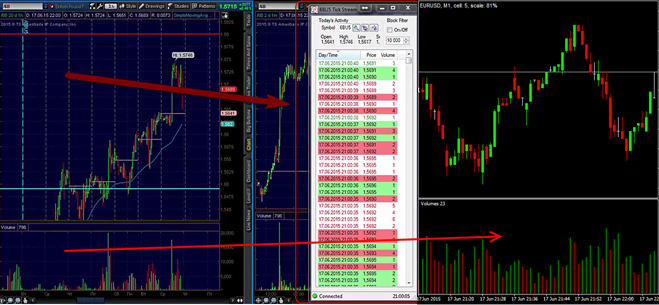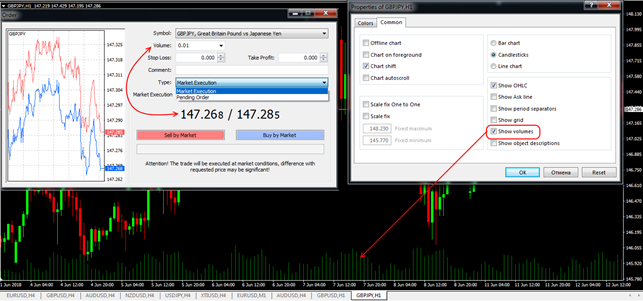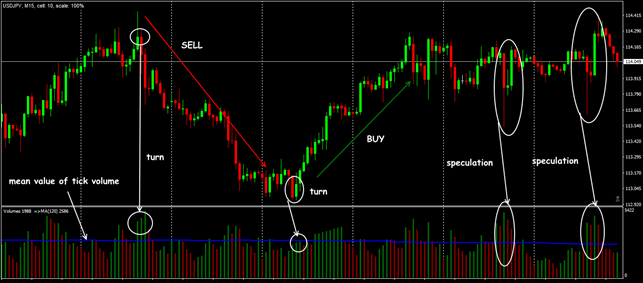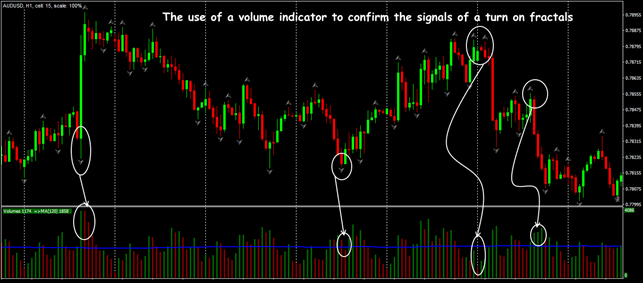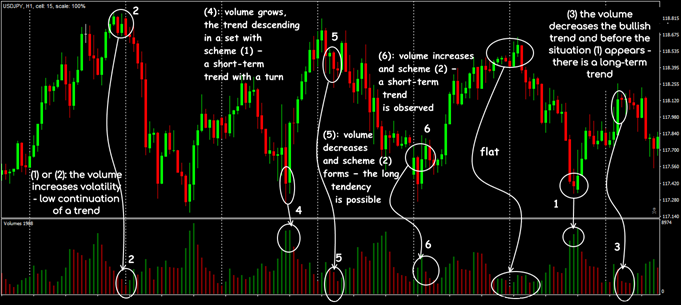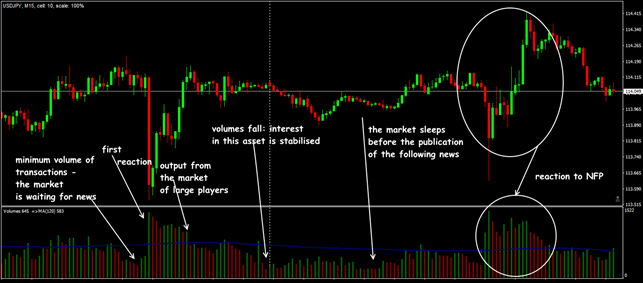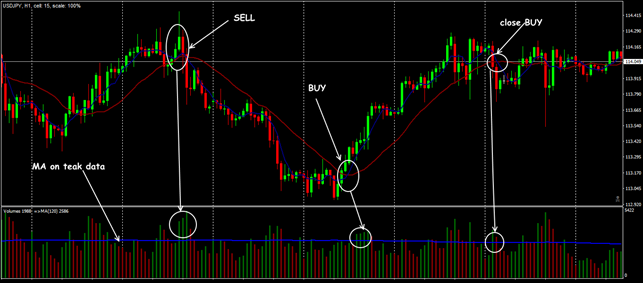Summarize at:
Behind any price movement in the market is a specific person with a certain amount of money, trading target, and personal psychology.
At the same time, the market volume is subject to the usual laws of statistics, so the trader needs a technical tool that will show in the trading terminal at least an approximate picture of what is happening in the real market.
Due to its decentralization, the Forex market cannot show us the real (monetary) volume of transactions. Still, it offers information about the number of price changes per unit of time for analysis.
Let’s take a closer look at how effective and useful the Volumes indicator is for us.
An introduction to the concept of “tick volume”
Initially, goods, and then the rest of the financial assets, were sold on the stock exchange by the principle of auctions, and the trading lot (goods, raw materials, share) were rigidly standardized. In this case, a fixed trade with an optimal (usually maximum) price was considered a trading tick, and a standard volume, respectively, was the tick volume (see Volume and volume indicators).
To check this (or any other) strategy’s performance you can:
During the process of the exchange development, direct trading orders to brokers (intermediaries between the exchange and customers), which contained the price of the asset and any, including fractional, quantity, came to replace the auction. The market price began to be determined by the volume of demand in its classical formulation. That is, if the price offered in the transaction differed from the current market, the transaction became deferred and formed, depending on the direction (purchase/sale), an exchange offer or demand.
The broker put the order into action when the market and order price had the same (or acceptable within the spread) value.
Volumes: MT4 (5) and Thinkorswim.
MetaTrader®, MetaTrader 5®, MT4®, MT5® are the registered trademarks of MetaQuotes Software Corp.
The price multiplied by the desired amount of an asset in the transaction, in total expression, is the tick volume – so the modern market understands it.
What we see today in the Forex terminal represents the number of price ticks per unit of time, where the tick itself is the “trading fact” of the change in the asset price by one base point. The tick works as a statistical counter of fluctuations and is not connected to the amount of money in transactions.
Logic and purpose
The Volumes indicator shows the total number of trade transactions completed (open and closed) for the billing period.
These data do not reflect the actual amount of money invested by the participants in the purchase/sale. The newcomer’s entry on a cent account and a large player, in terms of tick volume, are absolutely equal operations.
100 deals for 0.1 lot Volumes will be considered as 100 transactions (superactive dynamics!), and one trading order for 100 lots, as one transaction.
This way, a deal with a large trading volume and a small lot volume transaction will be statistically treated as equal. However, their real impact on the price will be significantly different. One can only hope that the weighted averages of the tick volume correctly reflect the overall dynamics.
The interpretation of the Volumes value is quite simple: if (visually) with an active price movement the volume indicator increases sharply, then it means the growth of active commercial interest in this direction, and it should be “true” rather than market noise. In fact, this indicator is never late.
Remember:
The value of Volumes is not a global market indicator. Tick volume displays the number of price changes for the period received from a particular liquidity provider; that is, the values in the terminals of different brokers will differ.
Calculation procedure
Tick volume is calculated only upon the completion of transactions.
It is assumed that the clients’ transactions are always executed at the best price for them, that is, at a price equal to bid or ask at the time the broker receives the trade order.
Technically, there is always an order execution time (a pause for the broker to send an order to the exchange). Still, the broker must execute the order even if the price changes; accordingly, the tick volume will become different. As a result, the tick volume may be higher than the declared value.
If the client sends the order with a request for an immediate transaction (buy at market price, at any price), the volume is also unknown in advance.
Despite the known quantity and approximate price of supply or demand, pending orders that are declared at prices at the spread boundary may not find a sufficient amount of the opposite interest on the market. Then the tick will be executed at different prices, which will affect the final volume.
The tick volume can be estimated only in relation to neighboring ticks − more, less, or a deviation from the average value for the period.
One vertical column of the indicator shows the total volume passed on this bar, even if the price change was insignificant and does not affect the overall dynamics.
Parameters and control
The Volumes indicator with minimum parameters is available as a visual service on most trading platforms (see the diagram above), but most often, different versions of external indicators are used and displayed in a separate window as a multicolored oscillator or line.
You can find options with a special information block that separately shows the number of Buy/Sell transactions (TicksVolumes, BuyVolumes, SellVolumes) and the volume dynamics in percent in the network.
The volume histogram estimates the trend in height and colour of the oscillator column: red indicates a decrease in the tick volume for the current period compared to the previous one, and green indicates its growth.
The Volumes indicator do not give explicit signals, but their dynamics accurately reflect the current state of the market.
Trading signals of the Volumes indicator
Trading with the Volumes indicator is a rather conventional mechanism. The benefit of using such information is not always clear, particularly for beginners, especially since the analysis of price/volume dynamics allows an implicit interpretation.
Let’s briefly consider the standard situations, but with the obligatory «or»:
- If the value of Volumes increases on the active price movement, — the participants actively add volumes to the current direction. We enter only the main trend.
- The price is growing, but the volume is decreasing: the demand for the asset is reduced − a reversal or a transition to a flat is possible.
- The decrease in the amplitude of the Volumes histogram − the results are fixed, new deals are not opened − the market doubts the current trend.
- If the price moves in the range and the volume decreases − a flat for a long time.
- Volumes grow in the breakout zone of a strong price level − confirmation of a breakdown signal. The reverse situation is a «false» breakdown.
- The minimum volume characterizes the points corresponding to the completion of correction in the case of a bullish trend, and the points corresponding to local maxima should have a maximum volume. On the downward trend, the Volumes grow with the reduction of quotations.
Traditionally, a divergence of price and Volumes histogram are considered a strong reversal signal.
Volume growth with minimal price dynamics means two possible situations:
- there are no major players, and the tick volume is created by many small transactions that are unable to move the price decisively – we do not enter the market;
- transaction volumes are quite large, but they are open in different directions – the enthusiasm of “fighting” bulls is approximately equal to the strength of “fighting” bears, and if we have not been yet participating in this battle, we do not open new positions. If there are open deals already, then at least, pull up Stop Loss or close and “sit on the fence”.
A few practical remarks
The eternal dispute of traders about the values priority of “real” and tick volumes is far from a truce. If the use of real Volumes often requires paid access to stock data, the main problem in analysing the tick volume is the lack of information about the resulting volume direction.
We remind you: if you select analogs of exchange trading assets in the form of CFDs (indices, raw futures, metals) in the Forex terminal — the Volumes indicator will show all the same tick volumes and not the amount of real money in transactions.
It means that tick histograms cannot correctly determine which transactions (in the amount of money) prevailed in the market at the estimated time of purchase or sale. Moreover, the presence of open interest is not taken into account, that is, already open positions that support the current trend (Swing Trading Charts).
And although practice shows that tick volumes are indispensable for assessing the degree of “nervousness” (volatility) of the market, the Volumes indicator can be used in any strategy, but only to confirm the main signals.
 Try Forex Tester Online
Try Forex Tester Online
 ไทย
ไทย
 Tiếng Việt
Tiếng Việt
 Polski
Polski
 Türkçe
Türkçe
 Nederlands
Nederlands
 Română
Română
 한국어
한국어
 Svenska
Svenska
